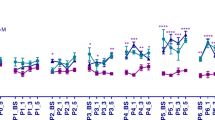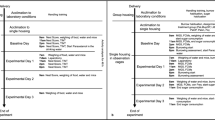Abstract
Many researchers are reluctant to administer analgesia after rodent embryo transfer, primarily out of concern that analgesia will affect embryo implantation. According to the Animal Welfare Act and the Guide, however, embryo transfer constitutes major survival surgery and is likely to cause pain and distress despite its minimally invasive nature. The authors examined the effects of a single dose of the analgesic buprenorphine on mice that underwent embryo transfer. In mice treated with buprenorphine, the number of viable implanted embryos was typically equal to or greater than that in untreated mice. All mice seemed quiet, alert and active after surgery.
This is a preview of subscription content, access via your institution
Access options
Subscribe to this journal
We are sorry, but there is no personal subscription option available for your country.
Buy this article
- Purchase on Springer Link
- Instant access to full article PDF
Prices may be subject to local taxes which are calculated during checkout
Similar content being viewed by others
References
Hogan, B. et al. in Manipulating the Mouse Embryo, A Laboratory Manual 2nd edn. (eds. Hogan, B., Beddington, H., Constantini, F. & Lacy, C.) Section C 127–188 (Cold Spring Harbor Press, Plainview, NY, 1994).
United States Department of Agriculture. Animal Welfare Act and Animal Welfare Regulations (USDA, Beltsville, MD, 1992).
Institute of Laboratory Animal Resources, National Research Council. Guide for the Care and Use of Laboratory Animals 64 (National Academy Press, Washington, DC, 1996).
Danneman, P.J. in Anesthesia and Analgesia in Laboratory Animals (eds. Kohn, D.F., Wixson, S.K., White W.J. & Benson, G.J.) ch. 6 83–103 (Academic, San Diego, 1997).
United States Department of Agriculture. Animal Care Policy Manual policy #11 (USDA, Beltsville, MD 1997).
Bokhari, A. & Pollard, B.J. Anaesthesia for assisted conception: a survey of UK practice. Eur. J. Anaesthesiol. 16, 225–230 (1999).
Huang, J.C., Wun, W.S., Goldsby, J.S., Matijevic-Aleksic, N. & Wu, K.K. Cyclooxygenase-2-derived endogenous prostacyclin enhances mouse embryo hatching. Hum. Reprod. 19, 2900–2906 (2004).
Lim, H. et al. Cyclo-oxygenase-2-derived prostacyclin mediates embryo transfer implantation in the mouse via PPARdelta. Genes Dev. 13, 1561–1574 (1999).
Himmelseher, S. & Durieux, M.E. Ketamine for perioperative pain management. Anesthesiology 102, 211–220 (2005).
Wagner, A.E., Walton, J.A., Hellyer, P.W., Gaynor, J.S. & Mama, K.R. Use of low doses of ketamine administered by constant rate infusion as an adjunct for postoperative analgesia in dogs. J. Am. Vet. Med. Assoc. 221, 72–75 (2002).
Grant, C., Summersides, G.E. & Kuchel, T.R. A xylazine infusion regimen to provide analgesia in sheep. Lab. Anim. 35, 277–281 (2001).
Flecknell, P.A. Postoperative analgesia in rabbits and rodents. Lab. Anim. 20, 34–37 (1991).
Roughan, J.V. & Flecknell, P.A. Buprenorphine: a reappraisal of its antinociceptive effects and therapeutic use in alleviating post-operative pain in animals. Lab. Anim. 36, 322–343 (2002).
Goecke, J.C., Awad, H., Lawson, J.C. & Boivin, G.P. Evaluating postoperative analgesics in mice using telemetry. Comp. Med. 55, 37–44 (2005).
Acknowledgements
We thank Nicole Stokes, Aimee Williams and Tiffany Borjeson for their invaluable assistance in the technical aspects of this paper, as well as the animal care staff at Children's Hospital Boston. We thank Brian Francis for his assistance in the statistical analysis of this study.
Author information
Authors and Affiliations
Corresponding author
Ethics declarations
Competing interests
The authors declare no competing financial interests.
Rights and permissions
About this article
Cite this article
Krueger, K., Fujiwara, Y. The use of buprenorphine as an analgesic after rodent embryo transfer. Lab Anim 37, 87–90 (2008). https://doi.org/10.1038/laban0208-87
Received:
Accepted:
Issue Date:
DOI: https://doi.org/10.1038/laban0208-87



